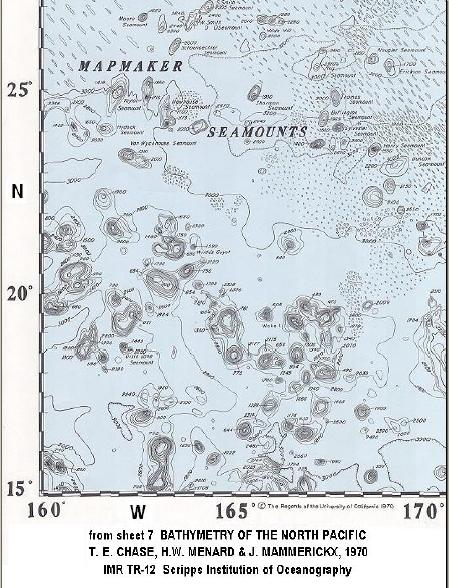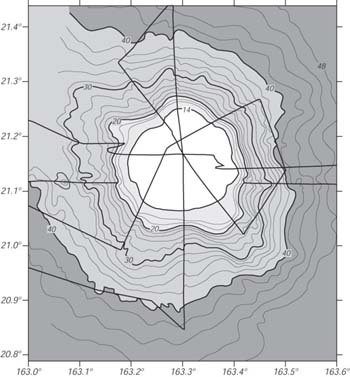Wilde's Guyot
 expandable pdf version
expandable pdf version
 An example of a seamount, the Wilde guyot. A guyot is a seamount
with a flat top created by wave action when the seamoune sea level. As the seamount is
carried by plate motion, it gradually sinks deeper below sea level.
The depth was contoured from echo sounder data collected along the ship track
(thin straight lines) supplemented with side-scan sonar data. Depths are in units of 100 m.
From William Sager, Texas A&M University.
Chapter 3 Oceanography in the 21th Century - an On-line Textbook,
Robert Stewart, Texas A&M University
*******
Samples from
ARIES EXPEDITION
Scripps Institution of Oceanography
November 1970 - October 1971
Depths Corrected by Matthews’ Tables
R/V Thomas Washington
ARIES 20D 23 May 1971, 0821-1007 hrs.; 21° 09.6’N, 163° 08.8’E; depth 1468-1406 m. Approx. 200 lbs.of
white, fine-grained limestone or ash, similar to ARIES 19D, except conglomerate has small
basalt pebbles and is suboradinate to white fine-grained material. Mn crust is up to 3 cm thick
on some specimens. Slabs of rock are up to 2 feet across. Foraminifera in white material are of
Eocene age.
Top of Wilde’s Guyot. Age 92 MY Cretaceous - Turonian according to ODP 144
References
Ozima, M., Masahiko Honda, K. Saito (1977) 40Ar—39Ar ages of guyots in the western Pacific
and discussion of their evolution Geophysical Journal International 51 (2) , 475–485
Winterer, E. L., J. H. Natland, R. J. Van Waasbergen, R. A. Duncan, M. K. McNutt, C. J. Wolfe, I. Premoli
Silva, W. W. Sager, and W. V. Sliter, Cretaceous guyots in the northwest Pacific: An overview of their geology
and geophysics, in The Mesozoic Pacific: Geology, Tectonics, and Volcanism, Geophys. Monogr. Ser., vol. 77,
edited by M. S. Pringle et al., pp. 307–334, AGU, Washington, D. C., 1993.
+++++++
An example of a seamount, the Wilde guyot. A guyot is a seamount
with a flat top created by wave action when the seamoune sea level. As the seamount is
carried by plate motion, it gradually sinks deeper below sea level.
The depth was contoured from echo sounder data collected along the ship track
(thin straight lines) supplemented with side-scan sonar data. Depths are in units of 100 m.
From William Sager, Texas A&M University.
Chapter 3 Oceanography in the 21th Century - an On-line Textbook,
Robert Stewart, Texas A&M University
*******
Samples from
ARIES EXPEDITION
Scripps Institution of Oceanography
November 1970 - October 1971
Depths Corrected by Matthews’ Tables
R/V Thomas Washington
ARIES 20D 23 May 1971, 0821-1007 hrs.; 21° 09.6’N, 163° 08.8’E; depth 1468-1406 m. Approx. 200 lbs.of
white, fine-grained limestone or ash, similar to ARIES 19D, except conglomerate has small
basalt pebbles and is suboradinate to white fine-grained material. Mn crust is up to 3 cm thick
on some specimens. Slabs of rock are up to 2 feet across. Foraminifera in white material are of
Eocene age.
Top of Wilde’s Guyot. Age 92 MY Cretaceous - Turonian according to ODP 144
References
Ozima, M., Masahiko Honda, K. Saito (1977) 40Ar—39Ar ages of guyots in the western Pacific
and discussion of their evolution Geophysical Journal International 51 (2) , 475–485
Winterer, E. L., J. H. Natland, R. J. Van Waasbergen, R. A. Duncan, M. K. McNutt, C. J. Wolfe, I. Premoli
Silva, W. W. Sager, and W. V. Sliter, Cretaceous guyots in the northwest Pacific: An overview of their geology
and geophysics, in The Mesozoic Pacific: Geology, Tectonics, and Volcanism, Geophys. Monogr. Ser., vol. 77,
edited by M. S. Pringle et al., pp. 307–334, AGU, Washington, D. C., 1993.
+++++++
 expandable pdf version
expandable pdf version

expandable pdf version